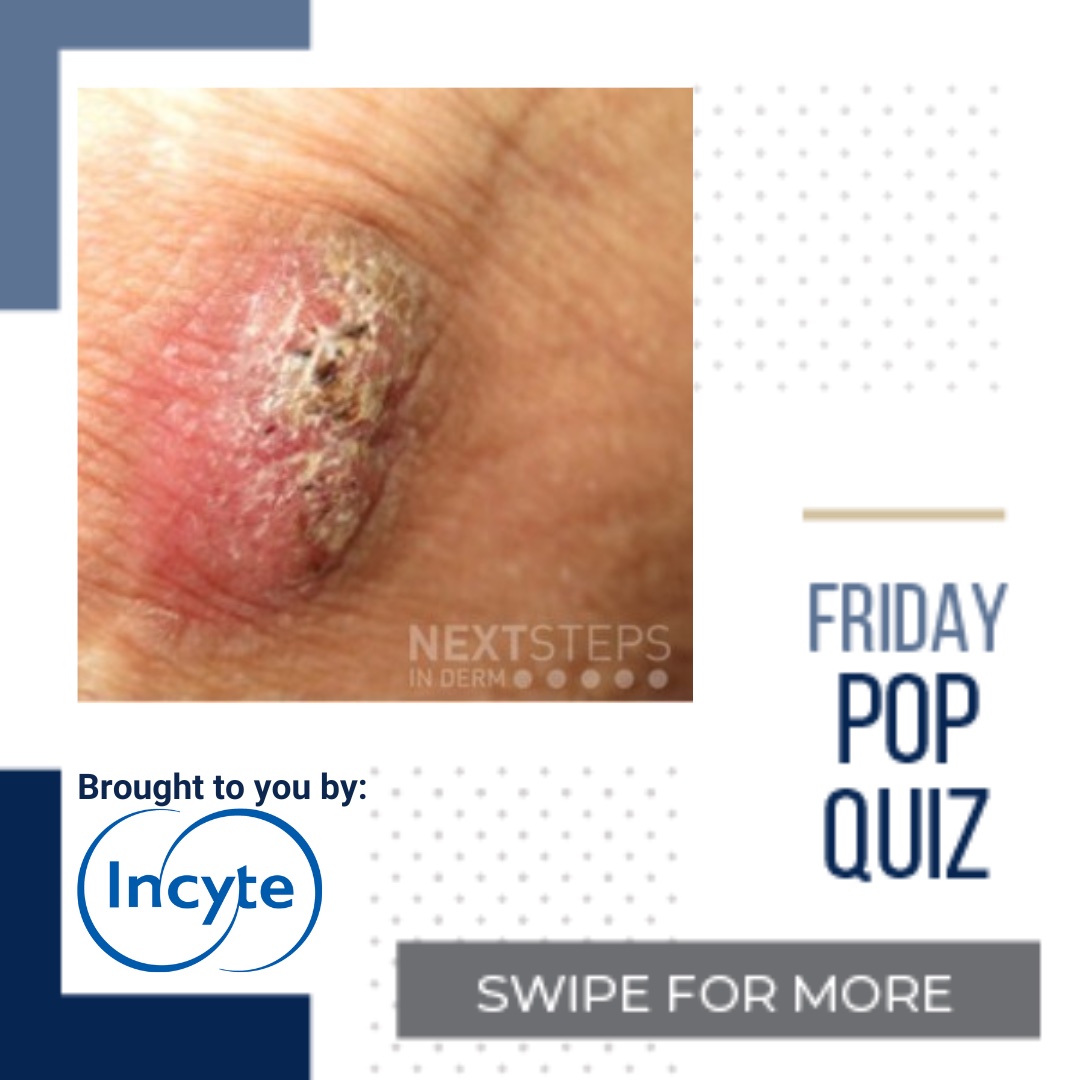Skin Rash – Friday Pop Quiz 6/23/2023
177171771717717 Which of the following treatments for the shown rash with 15% body surface area (BSA) involvement is least likely to be associated with an infection?
A. Methotrexate
B. Cyclosporine
C. Adalimumab
D. Infliximab
E. Acitretin
To find out the correct answer and read the explanation, click here.
Brought to you by our brand partner
…
Which of the following treatments for the shown rash with 15% body surface area (BSA) involvement is least likely to be associated with an infection?
A. Methotrexate
B. Cyclosporine
C. Adalimumab
D. Infliximab
E. Acitretin
To find out the correct answer and read the explanation, click here.
Brought to you by our brand partner
…
 Which of the following treatments for the shown rash with 15% body surface area (BSA) involvement is least likely to be associated with an infection?
A. Methotrexate
B. Cyclosporine
C. Adalimumab
D. Infliximab
E. Acitretin
To find out the correct answer and read the explanation, click here.
Brought to you by our brand partner
…
Which of the following treatments for the shown rash with 15% body surface area (BSA) involvement is least likely to be associated with an infection?
A. Methotrexate
B. Cyclosporine
C. Adalimumab
D. Infliximab
E. Acitretin
To find out the correct answer and read the explanation, click here.
Brought to you by our brand partner
… 

 What is the most likely complication from the treatment of this condition?
A. Dysgeusia
B. Sedation
C. Reversible motor neuropathy
D. Reversible corneal deposits
E. Exuberant granulation tissue
To find out the correct answer and read the explanation, click here.
Brought to you by our brand partner
…
What is the most likely complication from the treatment of this condition?
A. Dysgeusia
B. Sedation
C. Reversible motor neuropathy
D. Reversible corneal deposits
E. Exuberant granulation tissue
To find out the correct answer and read the explanation, click here.
Brought to you by our brand partner
…  A 35-year-old woman presents to the office for 6 months of lesions as shown on her knees and elbows. Treatment is initiated, and three weeks later, the patient presents to the emergency department with fatigue, headache, and shortness of breath. Which of the following is the next best step in the management of this patient?
A. Initiate methylene blue therapy
B. Obtain chest x-ray
C. P …
A 35-year-old woman presents to the office for 6 months of lesions as shown on her knees and elbows. Treatment is initiated, and three weeks later, the patient presents to the emergency department with fatigue, headache, and shortness of breath. Which of the following is the next best step in the management of this patient?
A. Initiate methylene blue therapy
B. Obtain chest x-ray
C. P …  Which of the following is the most likely cause of the lesion shown, which has sarcoidal granulomas on histopathology and colorless, birifrigent crystals on polarized light?
A. Aluminum
B. Gout
C. Sarcoidosis
D. Silica
E. Zirconium
To find out the correct answer and read the explanation, click here.
Brought to you by our brand partner
…
Which of the following is the most likely cause of the lesion shown, which has sarcoidal granulomas on histopathology and colorless, birifrigent crystals on polarized light?
A. Aluminum
B. Gout
C. Sarcoidosis
D. Silica
E. Zirconium
To find out the correct answer and read the explanation, click here.
Brought to you by our brand partner
…  A 38-year-old woman presents with multiple bothersome papules on her nose, as shown. She had previously been seen for these lesions and was treated with benzoyl peroxide wash and oral clindamycin with minimal improvement. Which of the following is the most likely diagnosis?
A. Acne excoriee
B. Atypical mycobacterial infection
C. Foreign body granuloma
D. Hodgkin lymphoma
E. Lup …
A 38-year-old woman presents with multiple bothersome papules on her nose, as shown. She had previously been seen for these lesions and was treated with benzoyl peroxide wash and oral clindamycin with minimal improvement. Which of the following is the most likely diagnosis?
A. Acne excoriee
B. Atypical mycobacterial infection
C. Foreign body granuloma
D. Hodgkin lymphoma
E. Lup …